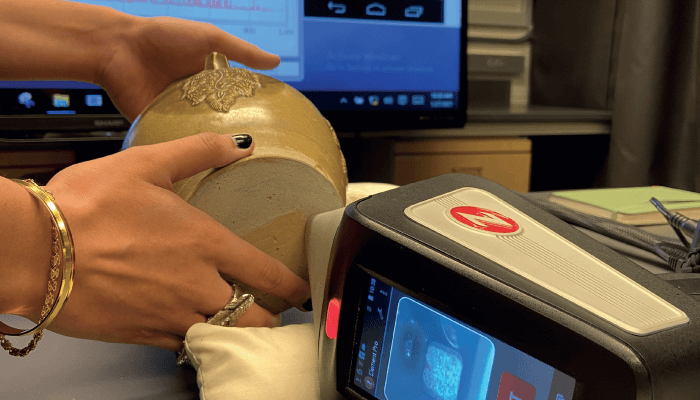
Are you using laser-induced breakdown spectroscopy (LIBS) in any of your projects?
We’ve used it for a few projects. We utilized LIBS to find out whether a piece of Chinese jewelry – a gigantic necklace in a series of interconnected little silver cones – was silver plated or solid silver. XRF can detect silver but cannot penetrate deeply into the metal. We decided to apply LIBS in a very inconspicuous spot, slowly making a tiny crater the width of a human hair down through the silver to explore the stratigraphy of the metal. We were able to determine that it was silvered and not solid silver. Admittedly, there may be other methods to achieve the same goal, but LIBS was also a really convenient way of gaining an approximate thickness of the silver coating at the same time.
We’ve also analyzed over 100 Chinese ceramics for a book being written by one of the curators at the Yale University Art Gallery. For this project, we’ve been using a combination of LIBS and XRF because they are so complementary. LIBS allows us to detect some elements that XRF cannot, but XRF is actually better at seeing other elements that fall below the detection limit of LIBS. We also use chemometric tools to see if there are patterns in elemental composition.
What important advances have been made in portable LIBS?
I remember using a backpack unit that was developed by Ocean Optics. It looked (and felt) like an army backpack – and it came with a wand that looked a little like a metal detector. You could zap things on the ground, which was satisfying. It actually worked quite well for some applications, but it wasn’t always practical for some geological or archeological applications I was interested in. Since then, we’ve seen great developments in handheld units driven primarily by industrial applications – using LIBS for scrap metal sorting, or for positive material identification, to make sure you’re using the right component in a manufacturing process, or even looking at the carbon content of steel. Now there are five or six companies that make handheld LIBS systems that work much the same way as a handheld XRF device – and that’s remarkable. These devices have only been made commercially available over the past five years or so and represent a significant improvement on previous portable approaches.
What advances would you still like to see in LIBS?
When we use LIBS, we’re often looking for clues that tell us whether an object is from a particular region – our Chinese ceramic project is a good example of this need. But NIST standards do not exist for such work, so you have to use chemometrics and machine learning tools to group similar things together. Right now, you need to become a competent data scientist or collaborate with one to access the power of LIBS. I would love to see more development of chemometric tools for non-expert users, to increase accessibility. It would be great if a scientist could start using LIBS without in-depth data science knowledge and instead simply input data into a program that tells them whether there’s any clustering. I believe there are some companies working on such data analysis tools – and they will really complement handheld LIBS.
For more quick tips for LIBS from Richard Hark, click here!
And to learn about Richard’s work putting the Vinland Map controversy to bed once and for all, click here!




